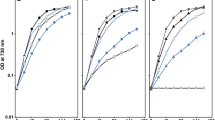Summary
The Feulgen-positive and envelope-free nucleoplasm ofAnabaena andGloeocapsa contains DNA filaments. When ultracentrifuged it is displaced between the maze of photosynthetic lamellae to form a continuous, flattened layer in the centripetal half of the cell. The absence of a mesosome and lack of attachment of the nucleoplasm to the plasmalemma make the method of duplication and separation of the genome to the progeny an enigma. In the centripetal end of ultracentrifugedAnabaena, the photosynthetic lamellae are somewhat stretched and sometimes broken. This condition suggests that the cortical positioned photosynthetic lamellae are tightly connected in several places along their surfaces to an undisplaced cortical cytoplasmic layer. It is uncertain whether or not they are also directly attached to the plasmalemma. A vesicle is often observed in the centripetal end of the cell; it probably represents for the most part, the contents of distorted intralamellar spaces. In ultracentrifugedGloeocapsa, the photosynthetic lamellae show little displacement. They appear attached, probably at their ends to the plasmalemma and, likeAnabaena andNostoc, they possess phycobilisomes which are not greatly affected by ultracentrifugation. Cells usually survive a centrifugal force greater than required to separate most nonliving protein systems. When subcultured, a redistribution of the displaced components usually occurs and growth is resumed.
Similar content being viewed by others
References
Beams, J. W., 1937: High rotational speeds. J. app. Phys.8, 796–806.
—,A. J. Weed, andE. C. Pickels, 1937: The ultracentrifuge. Science78, 338–340.
Bisalputra, T., B. R. Oakley, D. C. Walker, andC. M. Shields, 1975: Microtubular complexes in blue-green algae. Protoplasma86, 19–28.
Caro, L. G., 1969: Chromosomes of bacteria. In: Handbook of molecular cytology (Limade Faria, ed.). Amsterdam: North Holland Publishing Company.
Gantt, E., 1975: Physobilisomes: light-harvesting pigment complexes. Bio. Sci.25, 781–788.
—, andS. F. Conti, 1969: Ultrastructure of blue-green algae. J. Bacteriol.97, 1486–1493.
Echlin, P., andI. Morris, 1965: The relationship between blue-green algae and bacteria. Biol. Rev.40, 143–187.
Fuhs, G. W., 1969: The nuclear structure of protocaryotic organisms (bacteria andCyanophyceae). Protoplasmatologia5, 1–196.
Harvey, E. B., 1936: Parthenogenetic merogony or cleavage without nuclei inArbacia punctulata. Biol. Bull.71, 101–121.
Jensen, T. E., andC. C. Bowen, 1970: Cytology and blue-green algae. II. Unusual inclusions in the cytoplasm. Cytologia35, 132–152.
—, andR. P. Ayala, 1976: The fine structure of a microplate-microtubule array, microfilaments and polyhedral body associated microtubules in several species ofAnabaena. Arch. Mikrobiol.111, 1–6.
Kessel, R. G., 1973: Structure and function of nuclear envelope and related cytomembranes. In: Progress in surface and membrane science (Danielli, J. F., M. D. Rosenberg, andD. A. Cadenhead, eds.)6, pp. 243–320. New York: Academic Press.
Lang, N. J., 1968: The fine structure of blue-green algae. Ann. Rev. Microbiol.22, 15–46.
Leak, L. V., 1965: Electron microscopic autoradiography incorporation of3H-thymidine in blue-green algae,Anabaena sp. J. Ultrastruct. Res.12, 135–146.
—, 1967: Fine structure of the mucilaginous sheath ofAnabaena sp. J. Ultrastruct. Res.21, 61–74.
Morré, D. J., andW. J. van der Woude, 1974: Macromolecules regulating growth and development (Hay, E. D., andJ. Papaconstantinou, eds.). New York: Academic Press.
Pankratz, S. H., andC. C. Bowen, 1963: Cytology of blue-green algae. I. The cells ofSymploca muscorum. Amer. J. Bot.50, 387–399.
Ris, H., andR. N. Singh, 1961: Electron microscope studies on blue-gree algae. J. biophys. biochem. Cytol.6, 63–80.
Stanier, R. Y., R. Kunisawa, M. Mandel, andG. Cohen-Bazire, 1971: Purification and properties of unicellular blue-green algae (orderChroococcales). Bacteriol. Rev.35, 171–205.
Wildman, R. B., andC. C. Bowen, 1974: Phycobilisomes in blue-green algae. J. Bacteriol.117, 866–881.
Wolk, C. P., 1973: Physiology and cytological chemistry of blue-green algae. Bacteriol. Rev.37, 32–101.
Author information
Authors and Affiliations
Rights and permissions
About this article
Cite this article
Beams, H.W., Kessel, R.G. Physical properties of blue-green algae: Ultracentrifugation and electron microscope studies. Protoplasma 92, 229–242 (1977). https://doi.org/10.1007/BF01279460
Received:
Issue Date:
DOI: https://doi.org/10.1007/BF01279460




